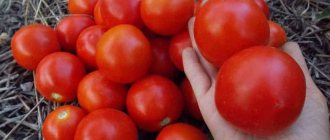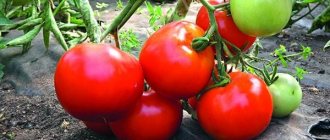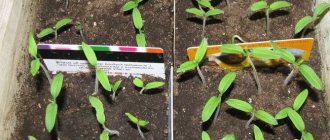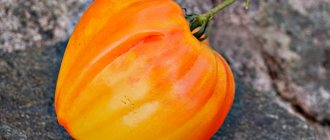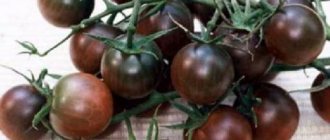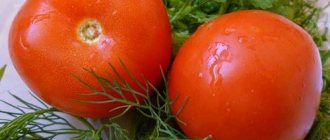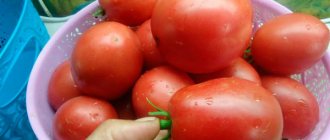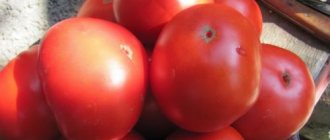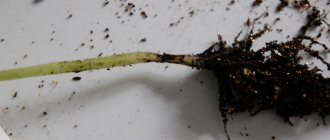History of the variety's creation
It is unknown who created this variety, so experts say that the Bear's Paw tomato is the fruit of folk selection.
This vegetable plant can be grown in garden beds in open ground, in film greenhouses. And in the middle zone, Moscow region and other regions with similar climatic conditions, it is better to plant this tomato in the closed ground of a greenhouse or greenhouse.
Photo of Bear Paw tomato
Advantages and disadvantages of the variety
Tomatoes of the Bear Paw variety have the following clear advantages over other varieties:
- wonderful taste;
- high yield;
- tomatoes of this variety can be grown both in a greenhouse and in open ground;
- good commercial quality of fruits;
- tomatoes can withstand transportation over long distances;
- long storage period;
- large-fruited fruits;
- undemanding plant care;
- excellent immunity to many diseases;
- the variety tolerates dry weather well;
- mid-ripening makes it possible to obtain ripe tomatoes in early July;
The disadvantages of the Bear Paw variety include:
- the need for shaping, tying and pinching bushes;
- Fruits cannot be used for whole canning.
- Not everyone will like the acidity in the taste of tomatoes.
Description of the variety
These tomatoes are classified as indeterminate type
, so the growth of the central shoot is unlimited. Usually, when grown in greenhouses, where the growth of such vegetable crops is limited by the height of the room, vegetable growers pinch the top of the central shoot at the desired height.
The Bear's Paw tomato is classified as a mid-early variety.
From the moment of germination of the seed material to the harvesting of ripe fruits, at least 3.5-4 months pass.
Usually the height of such tomatoes is about 1.9-2.0 m, the shoots are well leafed, the color of the tops and foliage is dark emerald. The foliage is typical of tomatoes: round, slightly elongated with a sharp tip.
Brief overview of the Bear's Paw tomato - video
The flowers are small, yellow, collected in racemose inflorescences, each of which produces up to 4 ovaries.
Ripe Bearpaw tomatoes have a flat-round shape; ribbing, reminiscent of an animal’s paw, is clearly visible next to the stalk.
The weight of the fetus is about 0.8 kg. The ripening fruits have a smooth, dense skin that is dark green in color; after ripening, the color changes to dark red. The pulp is sugary, quite fleshy and juicy. The taste of ripe tomatoes of this variety is excellent - sweet pulp with a characteristic sourness. The number of seed chambers is more than 6, the number of seeds is average.
A characteristic feature of Bear Paw tomatoes is that you can also collect green fruits, which are gradually grown at home.
This is usually done in regions with a short summer season, when all the fruits from tomatoes of a given variety on the bushes do not have time to ripen and they have to be picked unripe.
Ripe fruits tolerate transportation well and have good shelf life.
Harvested tomatoes are versatile - they are used to prepare salads, added to hot dishes and snacks, and used in preserves for making sauces, ketchups, juices and lecho.
The Bear's Paw variety is characterized by increased resistance to periods of drought.
Productivity
Tomatoes ripen throughout the season. Maturation proceeds gradually from the lower hands to the upper hands. If you pick tomatoes at the technical ripeness stage, they will ripen well at home. By growing tomatoes of this variety in a greenhouse, the last harvest can be harvested in September.
One bush of tomatoes of the Bear's Paw variety can grow up to 30 kg of fruit. On average, the yield from one bush is approximately 12 kg of tasty and selected tomatoes. It is important to understand that productivity depends on care. It is very important to correctly shape the bushes as they grow and remove excess shoots and prevent the formation of a large number of trunks.
Attention! You can count on a high harvest only if you constantly take care of the plants.
Advantages of the variety
The main advantages of the Bear Paw tomato variety include:
- good yield;
- This is a mid-early tomato variety;
- large-fruited – tomatoes weigh up to 0.8 kg;
- excellent taste of Bear Paw and good presentation of ripe tomatoes;
- the harvested crop tolerates transportation well at any distance and has good shelf life;
- ripe fruits have a universal purpose;
- high resistance to periods of drought and major diseases.
Harvest tomato Bear's Paw - video
No particular disadvantages were found in the Bear's Paw tomato.
TOMATOES!
Tomato Summer Resident Tomato Casanova Tomato Primadonna F1
Reviews from gardeners who planted the variety
Nadine, Volgograd
I grew the Bear's Paw variety last year. I only planted two bushes. I planted some in the garden and the other in the greenhouse. Somehow it didn’t show itself very well in terms of yield, I thought that the tomatoes would be a little larger. The taste was real tomato, sweet and sour. I’ll plant it again this year and try to achieve better yields.
Olga, Udmurtia, Uva
I grew the Bear's Paw tomato in the hot summer of 2021 in the garden, first under film, and then in the sun. The bush grew powerful and tall, but the yield was average. The tomatoes had an interesting flattened triangular shape, reminiscent of a paw. Delicious, red, fleshy, 300 grams each. I left the variety in the collection, I will grow more.
Lana the Gardener
I bought Bear's Paw seeds from the Siberian Garden and grew them in a greenhouse. The tomatoes grew dark red and medium in size. There were no very large tomatoes at all. I really liked the taste. The shape was beautiful and there were no hangers at all. Now I’ll try to plant them in the garden and see how they perform there.
Harvest tomato Bear's Paw - description, video
Rules for planting tomato Bear Paw
The Bear Paw tomato variety is suitable for growing in open and closed ground.
In climates with short summers and cool climates, it is recommended to grow this variety exclusively in greenhouse conditions; moreover, in a greenhouse, a higher yield can be obtained from this variety.
Photo of growing Bear Paw tomato in a greenhouse
It is necessary to grow Bear Paw tomatoes using the seedling method.
In this case, it will be possible to get the harvest a little earlier. Bear Paw tomato seeds are planted in the first ten days of March. Soil for planting can be purchased at a specialized store, but experienced vegetable growers prepare a nutritious substrate at home. To do this, they mix garden soil and humus in equal parts. If the soil is heavy, you need to add sand and high-moor peat to it.
The substrate prepared at home should be disinfected before placing it in planting containers. To do this, place it in an oven heated to 180 degrees and keep it there for about an hour. In this way, the soil is prepared approximately 12-14 days before the intended planting, during which time beneficial microflora will be restored in the soil.
Photos of Bear Paw tomato seedlings
Planting seed material for germination is placed in warm water for 24 hours.
Containers for planting the Bear Paw tomato should be no more than 15 cm high. A nutrient substrate is poured into them and grooves no more than 1 cm deep are made in it. The seeds are laid out in containers so that the distance between them is about 1 cm, they are sprinkled with soil on top and spray the ground with a spray bottle.
GOOD TO KNOW!
Top rot of tomatoes in a greenhouse
You need to cover the top of the containers with polyethylene and place them in a dark, warm room. The air temperature in the room during this period should be at least 26 degrees Celsius.
Photo of Bear Paw tomato seedlings
Typically, sprouts begin to actively germinate 6-8 days after planting. Remove the film from the containers and transfer them to the windowsill. From this moment on, it is necessary to provide the seedlings with at least 24 hours of daylight. Plantings should be watered with filtered warm water.
Maximum fruiting of this tomato variety occurs in greenhouse conditions.
The Bear's Paw tomato is grown in greenhouses in regions with cold climates.
Tomato "Bear's Paw" in open ground - video
Bear Paw tomato seedlings should be transplanted into closed ground at the age of 45-60 days. By this time, the height of the plants is at least 25 cm, and at least 5 true leaves appear on them.
The greenhouse should be prepared for planting Bear Paw tomatoes in the autumn. At this time, it is disinfected, all plant debris is removed, and the soil is dug up. Beds for tomatoes in one place can be prepared once every three seasons. The top layer of soil in closed ground is changed every autumn to avoid the possible spread of diseases or pests.
Important!
When preparing beds for tomatoes, the soil should be fertilized. To do this, organic fertilizers and river sand are added to it.
INTERESTING TO KNOW!
Varieties of black tomatoes
The soil in the greenhouse should remain loose so that it allows moisture and oxygen to pass well to the roots of vegetable plants.
Tall varieties of tomatoes, which include the Bear Paw variety, should be planted at a distance of 0.6 m from each other. It is best to plant them in a checkerboard pattern - in this case, it will be easier to care for the plants, and the tomatoes will not interfere with each other’s growth.
In open ground, the Bear Paw tomato variety can be grown in warm regions.
In the autumn, beds are prepared for them, into which humus or well-rotted compost is added for digging.
Photo of transplanting Bear Paw tomatoes into open ground
When growing tomatoes in open ground, you should follow the rules of crop rotation and do not plant this vegetable crop after peppers or eggplants.
The best predecessors for tomatoes are:
- onion;
- garlic;
- any variety of cabbage;
- cucumbers;
- plants from the legume family.
Planting dates and care
There is nothing special in caring for the variety, but Bear’s Blood cannot be called a tomato for the lazy. It requires compliance with at least basic rules of agricultural technology.
Growing seedlings
From the moment the seeds hatch until they are planted in the ground, 45-55 days should pass. To calculate the sowing time, you need to focus on your own climate and long-term weather forecast. A week is added to the specified time for the preparation and germination of planting material.
Before sowing, the seeds are heated, disinfected, and soaked until they swell. Their germination rate is good. They dive after 1-2 true leaves appear. Water moderately, add light up to 12-14 hours a day. Hardening is carried out 2 weeks before planting.
Care after transplanting into the ground
Bear's blood is planted at 4-5 bushes per 1 square meter. m. Care is as follows:
- regular moderate watering;
- loosening or mulching beds;
- stepsoning;
- garter;
- fertilizing with a mineral complex - in the first half of the growing season with a large amount of nitrogen, after the extension of the second flower cluster, phosphorus, potassium, and calcium should predominate in the fertilizers;
- removing leaves under the fruit cluster that has begun to fill.
Features of care
With proper agricultural technology, the bush is low and medium-leafed. If nitrogen fertilizing is not controlled, the seedlings will stretch out. True, after moving into the ground it quickly grows stronger, the trunk becomes thick, and the internodes do not seem elongated.
But when gardeners continue to be zealous with nitrogen, the tomato:
- reaches a greater height than indicated in the variety description;
- builds up a powerful leaf apparatus, which delays flowering and ovary formation;
- the fruits become smaller.
This is confirmed not only by reviews of the Bear’s Blood tomato, but also by the few videos so far (see below).
To correct the situation, it is enough to follow the requirements of growing the crop. Namely, after the second flower cluster begins to extend, stop giving nitrogen. If the soil has been filled with organic matter since autumn or spring - completely. Otherwise, the crop will only need very small doses of N, and it is better to apply them by spraying the above-ground parts. So the bushes are unlikely to fatten.
It is better not to rush, and open the greenhouses only during the day. It is recommended to completely remove the film no earlier than the beginning of June, and it is definitely not worth removing it in May.
Further care for Bear Paw tomatoes
One of the important elements of further care for Bear Paw tomatoes is compliance with the watering regime. It is important to prevent the soil from drying out and forming a crust on its surface. Excess moisture also negatively affects the development of plants - this can provoke the development of fungal diseases.
Usually, tomatoes are watered every 3-4 days. But in hot, dry weather, the amount of watering can be increased. And during the rainy season, it is recommended to water this vegetable crop less often.
At least 3 liters of moisture must be added to each plant each time.
During the flowering period, the amount of water is increased to 5 liters. But at the same time, water the tomatoes once every 7 days. During the period of active fruit ripening, the amount of watering is sharply reduced, since excess moisture can cause cracking of the tomatoes.
Features of care
Proper care will allow you to get a high yield of tomatoes and avoid problems with the spread of diseases and pests. The care process includes adding moisture and fertilizers, pinching and tying up the bush.
Watering tomatoes
The Bear's Paw tomato variety requires moderate watering. It is important to prevent the soil from drying out and forming a hard crust on its surface.
As reviews and photos of the Bear's Paw tomato show, excess moisture also negatively affects plants. As a result, their development slows down and fungal diseases are provoked.
Advice! Tomatoes are watered once or twice a week, taking into account climatic factors.
After planting in a permanent place and abundant watering, the next application of moisture is postponed for a week. The water used must settle and warm up.
One tomato bush requires 3 liters of water. During the flowering period, add up to 5 liters of water, but the procedure is carried out no more than once a week. During fruiting, the intensity of watering is reduced to avoid cracking of the tomatoes.
Fertilizing plantings
The first feeding of tomatoes is done a week after transplanting the plants. You can use both minerals and folk remedies. There is a gap of 2 weeks between procedures.
Preference is given to fertilizers based on potassium or phosphorus. When watering, 30 g of superphosphate or potassium sulfate is dissolved in 10 liters of water. Phosphorus contributes to the development of tomatoes and the formation of a healthy root system. Potassium helps improve the taste of fruits.
Advice! Among the folk remedies, a universal fertilizer for tomatoes is ash, which is embedded in the soil or applied during watering.
During the flowering period, tomatoes are sprayed with boric acid (1 g of the substance is diluted in 1 liter of water). This feeding stimulates the formation of ovaries.
Bush formation
The Bearpaw tomato is formed into one or two stems. Lower leaves and side shoots must be removed. Stepping allows you to avoid excessive growth of green mass. You need to eliminate shoots growing from the leaf axil.
The variety in question is tall and therefore requires staking. A wooden or metal strip is used as a support. Tomatoes are tied at the top.
You can tie tomatoes to a support structure consisting of several supports. A wire is stretched between them, to which the plants are attached.
Fertilizing Bear Paw tomatoes
For the first time, you can feed Bear Paw tomatoes no earlier than 7-10 days after transplanting to a permanent place.
Mineral fertilizers, organic matter and folk remedies are used as fertilizers. Usually all these means alternate with each other. The fertilizing interval should be at least 12-14 days.
It is best to feed this vegetable crop with preparations containing potassium and phosphorus.
The usual dosage of mineral fertilizers is 2 tbsp. l. The preparations are diluted in a bucket of water and fertilized “at the root”. Ash can be used as a folk remedy.
During flowering, tomato bushes are treated with a solution of boric acid (2 g of the drug is diluted in 2 liters of water). This drug stimulates the active appearance of ovaries.
Planting and care
When to plant seeds for seedlings? The optimal time for sowing seeds is from the beginning of March to the beginning of April. The soil mixture is purchased from the Agrocenter or prepared independently. To do this, mix:
- 2 parts garden turf;
- 1 part rotted compost;
- 1 part sand;
- 1 part peat.
The seeds have good germination. You can speed up germination by pre-soaking them for 10 hours in Kornevin or Agate.
The depth touched 1.5 cm into the moistened soil. The top is easily compacted and covered with film. Keep until germination at a temperature of 25-26 degrees.
How to care for seedlings:
- irrigate with warm, settled water;
- dive with 2 true leaves into 0.3 l pots;
- fertilize 2 times - 10 days before the dive and 8-10 days after the procedure;
- hardening on the eve of transplantation for a week at 14 degrees at night and at 15-16 degrees during the day;
- lighting with a phytolamp to create daylight hours lasting 12-14 hours.
Recommended tomato varieties
TOMATO BEAR TRAIL.
An early-ripening, high-yielding variety for open and closed ground. The fruits are red, flat-round, ribbed, weighing 300-500 g, fleshy, juicy, incredibly sweet and aromatic.
Value of the variety: high yield, excellent taste, large-fruited, complex disease resistance, good fruit set in unfavorable weather conditions.
The quality of the seeds complies with GOST and is confirmed by a certificate!
5 Amazing reasons why you should buy seeds from us:
- The seeds are of excellent quality and have a long shelf life. Make sure by checking germination!
- We hold regular promotions and discounts.
- When purchasing over 2,000 rubles, we will deliver the seeds absolutely free!
- We give a sweet gift to every customer.
- If you are not satisfied with anything about our seeds, feel free to write to us, we will return your money!
Love and joy to you!
Payment and delivery
Free delivery by Russian Post for amounts over 2000 rubles (when sending seeds)!
Minimum order amount from 500 rubles!
Delivery
We have several delivery methods:
- Courier delivery
- Delivery by courier company
- Delivery by Russian Post
- Delivery by transport companies
Delivery by courier is carried out in Chelyabinsk
The cost of delivery of light cargo is 200 rubles.
The cost of delivery of large-sized cargo (sapropel from 20 liters, greenhouses, etc.) is calculated individually.
Delivery by courier company
The cost of delivery by courier company depends on the weight of the cargo and your location. Calculated individually.
Delivery by Russian Post
The cost of delivery of goods by Russian Post depends on what class the parcel is sent and the weight of the parcel.
We usually ship by Russian Post, the delivery cost is:
– 200 rubles – prepaid (seeds);
– from 300 rubles – payment upon receipt (cash on delivery)
Delivery by transport companies
Delivery of goods is carried out by the following transport companies, “Energia”, “PEK”.
The cost of cargo delivery by transport companies is calculated individually.
When you receive an order, our manager will contact you to clarify the details of the order and agree with you on a convenient delivery method.
Payment
You can pay for the goods:
- To a Sberbank card
- Electronic payment to Webmoney wallet
- Cash to the courier upon delivery
- Cash on delivery upon receipt of goods
The Bear's Trace tomato stands out among large-fruited varieties with excellent parameters. The most important trump card is unpretentiousness. During cultivation, it does not require close attention and the implementation of all agrotechnical techniques.
Tomato Bear Paw: reviews from those who grow
Natalya, 48 years old, Perm region: Tomato variety Bear's Paw was recommended to be planted by a neighbor in her summer cottage. I planted it and didn’t regret it. The bushes grew strong and powerful, and the large size of the fruits was simply amazing. I also liked the taste of the Bear Paw tomato - sweet with a slight hint of acid. The harvest tolerates transportation well and is stored for a long time.
Lisa, 39 years old, Irkutsk region: In our region, tomatoes are grown mainly only in greenhouses. For several years now, one of the best varieties for indoor ground has been Bear's Paw. This variety feels good in greenhouse conditions, and its yield is much higher than in open ground. In short, one of the best varieties for our climate, definitely.
Tatyana, 55 years old, Samara region: I appreciate the Bear Paw variety for its reliability and excellent taste of tomatoes. The germination rate of seed material is almost 100%. Over 5 growing seasons I have never collected less than 25 kg of ripe fruits per square. There is enough harvest not only for food, but also for supplies.
This tomato variety is high-yielding, can grow in open and closed ground, is practically disease-free and can be grown in most Russian regions. It is these qualities of the Bear's Paw tomato that are the reasons for its high popularity among vegetable growers.
Pests and diseases
The Bear's Paw variety is resistant to the main nightshade diseases: verticillium, late blight, fusarium wilt, and tobacco mosaic. However, preventive measures to prevent possible illnesses are necessary. Before planting, the soil is spilled with a hot solution of potassium permanganate. After watering, the windows of a greenhouse or greenhouse should be opened so as not to provoke the appearance of gray or white rot. It is recommended to mulch the soil with straw or peat; this procedure will prevent root rot.
It is very important to protect plantings from insect pests. Tomatoes are threatened by naked slugs, Colorado potato beetles, aphids, whiteflies, thrips, mole crickets, and spider mites.
Spraying with an aqueous solution of ammonia helps destroy slugs and larvae of Colorado beetles. You can get rid of aphids by washing the affected plants with soapy water. An effective way to combat flying insects is insecticide aerosols . Treatment with toxic drugs can be carried out before fruiting begins. After fruit set, preference is given to folk recipes: decoctions of celandine, chamomile, onion peel. Not only the affected bushes are sprayed, but also the tomatoes located nearby.
Tasty, large and juicy Bear Paw tomatoes are an excellent variety for gardeners who are not afraid of experiments. Plants take root well in a greenhouse or soil, but the yield is greatly influenced by temperature, watering and the quality of fertilizing. By finding a pattern that suits your tomatoes, you can reap an impressive harvest.
Description from the seed manufacturer
A mid-early, highly productive, large-fruited variety of amateur selection. The variety is characterized by a rare combination of large grain size and enviable yield. The fruits are flat-rounded, bright red, smooth, fleshy and sugary at the break. The weight of the fruit is also impressive - up to 800 g. 4-5 effective fruits are formed in the hand. The total yield reaches up to 6-8 kg per plant. The bush is powerful, 120-170 cm high, requires staking and pinching. The recommended planting density is no more than 3 plants per 1 square meter. m.
The variety responds well to watering and fertilizing with complex mineral fertilizers. To speed up the process of seed germination, improve plant health, and improve fruit set, it is recommended to use specially developed plant growth and development stimulants.
Reviews about the variety
Gardeners have different opinions; some like the variety, others don’t. Here are some opinions:
Tomat-pomidor forum
Forum forumhouse.ru
We are interested in your opinion about this variety, share your impressions in the comments!
Similar varieties
Tomatoes are similar in characteristics to Bear's Blood:
- Alsou. Tomato from agro, in the State Register since 2008. Early for open ground, determinate, with a bush height of about 80 cm. Tomatoes are flat-round in shape, red, fleshy, slightly ribbed, average weight without standardization - 300 g, chambers - 6 or more. Marketable yield per sq. m – 7 kg, total – higher.
- Big jackpot. The tomato is not included in the State Register; the selection is from the Siberian Garden. Determinate, early, long-term fruiting, up to 90-100 cm high. Recommended for open ground. The tomatoes are flattened, dark red, with faint ribs. The pulp is sweet, fleshy. From 1 sq. m harvest up to 12 kg.
- Vologda fruitful. Mid-early for open ground. Determinate, up to 1 m high. 250-400 g, fleshy tomatoes, multi-chambered, bright red, compressed at the poles. The tomato yields a harvest of up to 4 kg per bush.
Description of proper cultivation of seedlings
Considering numerous reviews of a particular variety, many gardeners make a choice in the direction of a certain type. But an equally important role is given to the peculiarities of its cultivation, since many often want to purchase a species that will be easy to grow and care for. You should start growing seedlings of this tomato around the very beginning of March. An ideal option for growing seedlings would be a peat tablet or special boxes in which this process will take place. Also, to simplify it, it is possible to create special peat cups, where the soil in which the seedlings will be grown will consist of:
- humus;
- garden soil;
- sand;
- peat
To create such a mixture, all components must be taken in equal quantities. It is recommended to first disinfect the planting material that you will plant in the prepared soil and check for germination indicators. The seeds need to be planted in slightly damp soil and the top of the container should be covered with some kind of film. After this, the containers should be hidden in a fairly warm place for about 5-6 days. This will allow the process of germination of the first shoots to occur. As soon as this happens, the film should be removed and the containers with sprouts should be placed in a lighted place. In order for this crop to develop well, the air temperature should be maintained within 23-240 C.
Description and characteristics of the Bear's footprint tomato, growing features
The Bear's Trace tomato is an indeterminate, drought-resistant variety, which is characterized by large growth and an original leaf shape, which is why it got its name. If you follow all the rules for growing the variety, you can get a bountiful harvest.
Description of the Bear's Trail variety
Next, the characteristics and description of the Bear's Trace variety will be presented.
Among large-fruited species, these tomatoes have the best parameters:
- The main advantage of the variety is its unpretentiousness. Tomatoes can grow in any climatic conditions, in almost any region of our country.
- Tomatoes have excellent immunity, so they are resistant to various diseases and easily tolerate both cold and heat.
- A tomato bush can have a height of more than 1 m. If the sprouts were healthy and strong, then the bush can grow up to 1.5 m. The leaves are large, dark green, with carved edges.
- The fruits are round in shape, flattened on the sides. These tomatoes are giants. The weight of one fruit can vary from 250 to 500 g. The fruit has dense dark red pulp.
Reviews from gardeners say that if you follow the watering conditions, you can get about 10 large fruits from one plant that have a pleasant sweetish taste. Bear track tomatoes can grow both in open ground and in greenhouses. In the northern regions it is grown mainly in greenhouses.
The bush needs to be formed. If pinching is not carried out, the plants grow to a height of more than 2 m. During pinching, no more than 2 stems are left on one bush. The bush must be grown by tying it to a support. If this is not done, the tomatoes will bend under the weight of the ripened tomatoes. Each shoot of the plant produces about 5 large fruits. The bear track is characterized by good transportability and the possibility of long-term storage.
How to grow Bear Trail tomatoes?
The description of the variety contains the main requirements for growing large-fruited tomatoes. The time for sowing seeds depends on where the crop is going to be grown: in a greenhouse or in open ground. In greenhouses, seeds should be sown in February. If tomatoes are grown in an open way, the seeds should be sown at the end of March.
Reviews from summer residents indicate that this variety requires long-term sunlight, so if you sow the seeds in the last ten days of March, the tomatoes will be provided with sufficient exposure to sunlight. In the greenhouse, to obtain good seedlings, it is necessary to maintain optimal air temperature and humidity. If the sprouts are too thin, it means they are not getting enough sunlight. Therefore, the lack of natural light must be compensated by artificial lighting of plants using fluorescent lamps.
When planting tomato seedlings in the ground, weather conditions are taken into account. In warm regions, planting in the ground can be done in mid-May. In cooler conditions, seedlings are planted after the threat of frost returns has passed.
You cannot plant sprouts in cold, unheated soil, since even shelter will not help the plant develop normally. The care method consists of regular watering, loosening the soil and hilling the plants. Hilling is carried out so that additional roots are formed on the bushes. The root system of this variety must be strong, penetrating deep into the ground.
Reviews from summer residents say that with proper care, the tomatoes are large, have a sweet taste and dense flesh. Tomatoes contain more pulp than seeds. The fruits are eaten both fresh and cooked. The tomato is excellent for canning, fermenting, pickling, making sauces, side dishes and seasonings, and using boiled and fried.
Thus, as evidenced by the reviews of those who grew the Bear's Trace variety, tomatoes are unpretentious, resistant to diseases and bad weather conditions. They have excellent fruit set and high yield.
Description of the plant
The variety received its funny name due to the distant similarity of its fruits to a bear’s paw. Rich red tomatoes are distinguished by their large size and rounded-flattened shape, with ribbing observed near the stalk. The glossy skin covers the juicy and fleshy pulp of the fruit. One tomato can weigh 700−800 g. The variety is loved by summer residents for its bright sweet taste with a sour aftertaste and a tart aftertaste.
Characteristics of the variety
The tomato is an indeterminate variety. It grows up to 2 meters in height, so it is often grown in high greenhouses, where it is easier to build reliable supports to support developing bushes. The stems are densely covered with dark green leaves.
4-6 fruits ripen on small clusters. The mid-season variety ripens 100−110 days after planting the seedlings. One bush brings up to 30 kg of tomatoes.
Description of tomatoes Evpator, Accordion, Intuition and others
The fruits are eaten fresh or canned. Bear Paw tomatoes are used to make tomato paste, sauces, purees and juices.
Among the advantageous characteristics of the variety are:
- High yield;
- Counteracting late blight and other diseases;
- Resistance to drought and cold;
- Possibility of transportation;
- Long-term storage;
- Easy to care for.
Taste qualities of Bear's blood tomatoes
The Bear's Blood variety belongs to the group of beef tomatoes, large-fruited, fleshy salad tomatoes. The fruit has a flat-round shape, weak ribbing, and dense consistency. in an immature state it is green with a dark spot, in a mature state it is bright red. These tomatoes are often called "fruity" tomatoes because of their sweet taste.
Important! Tomatoes are not suitable for pickling; they are more often used fresh, but you can make sauce and juice from them.
The fruits of the Bear's Blood variety are fragrant, tasty, and large. Their maximum weight reaches 500 g, the average is about 300 g.
